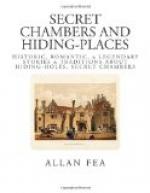[Footnote 1: Vide King Monmouth.]
[Illustration: MOYLES COURT, HAMPSHIRE]
[Illustration: TODDINGTON MANOR HOUSE, BEDFORDSHIRE, IN 1806 (FROM AN OLD DRAWING)]
Few hiding-places are associated with so tragic a story as that at Moyles Court, Hants, where the venerable Lady Alice Lisle, in pure charity, hid two partisans of Monmouth, John Hickes and Richard Nelthorpe, after the battle of Sedgemoor, for which humane action she was condemned to be burned alive by Judge Jeffreys—a sentence commuted afterwards to beheading. It is difficult to associate this peaceful old Jacobean mansion, and the simple tomb in the churchyard hard by, with so terrible a history. A dark hole in the wall of the kitchen is traditionally said to be the place of concealment of the fugitives, who threw themselves on Lady Alice’s mercy; but a dungeon-like cellar not unlike that represented in E. M. Ward’s well-known picture looks a much more likely place.
It was in an underground vault at Lady Place, Hurley, the old seat of the Lovelaces, that secret conferences were held by the adherents of the Prince of Orange. Three years after the execution of the Duke of Monmouth, his boon companion and supporter, John, third Lord Lovelace, organised treasonable meetings in this tomb-like chamber. Tradition asserts that certain important documents in favour of the Revolution were actually signed in the Hurley vault. Be this as it may, King William III. failed not, in after years, when visiting his former secret agent, to inspect the subterranean apartment with very tender regard.
CHAPTER IX
JAMES II.’S ESCAPES
We have spoken of the old houses associated with Charles II.’s escapes, let us see what history has to record of his unpopular brother James. The Stuarts seem to have been doomed, at one time or another, to evade their enemies by secret flight, and in some measure this may account for the romance always surrounding that ill-fated line of kings and queens.
James V. of Scotland was wont to amuse himself by donning a disguise, but his successors appear to have been doomed by fate to follow his example, not for recreation, but to preserve their lives.
Mary, Queen of Scots, upon one occasion had to impersonate a laundress. Her grandson and great-grandson both were forced to masquerade as servants, and her great-great-grandson Prince James Frederick Edward passed through France disguised as an abbe.
The escapades of his son the “Bonnie Prince” will require our attention presently; we will, therefore, for the moment confine our thoughts to James II.
With the surrender of Oxford the young Prince James found himself Fairfax’s prisoner. His elder brother Charles had been more fortunate, having left the city shortly before for the western counties, and after effecting his escape to Scilly, he sought refuge in Jersey, whence he removed to the Hague. The Duke of Gloucester and the Princess Elizabeth already had been placed under the custody of the Earl of Northumberland at St. James’s Palace, so the Duke of York was sent there also. This was in 1646. Some nine months elapsed, and James, after two ineffectual attempts to regain his liberty, eventually succeeded in the following manner.




